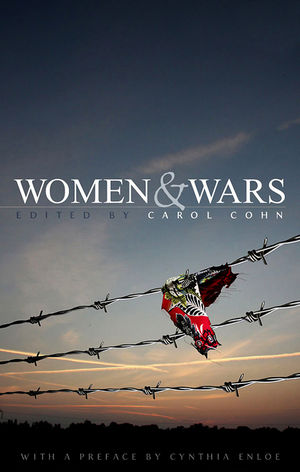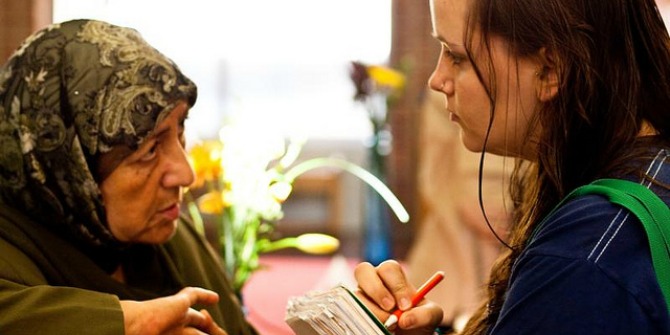In traditional historical and scholarly accounts of the making and fighting of wars, women are often nowhere to be seen. With few exceptions, war stories are told as if men were the only ones who plan, fight, are injured by, and negotiate ends to wars. As the pages of this book aim to tell, though, those accounts are far from complete. Christine Sylvester concludes that Women and Wars is a valuable collection for anyone interested in learning some of the ways feminist analysis is currently formulating, studying, and presenting its war questions.
 Women and Wars. Carol Cohn (ed.). Polity. October 2012.
Women and Wars. Carol Cohn (ed.). Polity. October 2012.
Carol Cohn’s dedication to the cause of peace is well-known and well-regarded, as is her early work on the seductions of military techno-strategic language (see “Sex and Death in the Rational World of Defense Intellectuals“). Cohn’s new edited book might be seen as a move away from studying peace to studying war: her introductory chapter says little directly about her reasons for presenting a volume of ten weighty contributions on women and wars. Deep in that chapter, however, she provides a hint: “attention to women’s lives helps us see that the familiar binary of “war and peace” obscures a far more complex reality” (p. 22). Indeed. A focus on peace outside of an equal focus on war – what it is, who is involved, and how it can shape women’s identities and experiences – can impart only a partial picture of complex realities in a period of globalization. I have been drawn in a similar direction and work with a range of international colleagues to understand war through the social relations of ordinary people’s experiences (see Experiencing War and War as Experience: Contributions from International Relations and Feminist Analysis). Cohn’s interest runs tandem with my own. The difference might be that her feminist focus in this volume is on gender and war (which includes issues of masculinity), and women and war in particular; whereas, the Experiencing War project I oversee starts from the premise that people in general are missing from studies of war in the field of International Relations. The recent attention to war experiences in both forms within feminist IR is the important factor: historically, feminism has weighed in far more on issues of peace, notwithstanding important work on gender and war by the likes of Cynthia Enloe, Jean Bethke Elshtain, Judith Stiehm, and, lately, Judith Butler.
Cohn leads off by foregrounding the importance of gender analysis for reconsidering war and its contributing institutions, principally the military. She explores the importance of placing gender within the larger social and material milieu of race, class, and global forces, and she urges analysts to look beyond official beginnings and endings of war to experiences that linger on well after the violence has ended. The emphasis of the book is on many gendered conditions, forces, dynamics, and interactions that bear on war and post-war experiences of many kinds. For example, there are chapters on sexual violence and issues of health in war (Pamela DeLargy), women and girl refugees (Wenona Giles), women in militaries (Mathers), women and anti-war activism (Cohn and Ruth Jacobson), and women in various post-war or opposition processes (Dyan Mazurana, alone on armed opposition groups, and with Linda Eckerbom Cole on women and DDR). Ruth Jacobson presents insights on women after wars, and women and peace processes are probed by the trio of Malathi de Alwis, Julie Mertus, Tazreena Sajjad. Angela Raven-Roberts urges the reader to consider specific wars in the context of global political economy in order to understand persistent war dynamics and the gendered practices that produce war victims and continuing war opportunities.
Mazurana’s ‘Women, Girls, and Non-State Armed Opposition Groups’ is one among several chapters that caught my attention. There is a long history of women becoming involved in militant actions to end colonization across Africa, from the Algerian women who couriered documents and weapons under voluminous clothing to armed women guerrillas of the southern African national liberation efforts. More recently, we remember the (in)famous woman killer in the Liberian wars, Black Diamond, whose group of bushwives were notorious for their fighting ferocity. Mazurana continues this tradition and comments on a number of contemporary oppositional movements that engage women: the LTTE in Sri Lanka, the Fuerzas Armadas Revolucionarias in Columbia, and women suicide bombers in a number of national contexts. The Tamil Tiger women of Sri Lanka were the so-called “Birds of Freedom,” but the author points to less poetic aspects of bringing women into LTTE as combatants, including a culture in the country that did not see women as threatening, a need to bolster manpower [sic], competition between various Tamil groups for power and authority, and recognition that international media paid attention to women in oppositional groups, especially if they were in combat roles and could convey their experiences to curious audiences. The women themselves joined for the usual variety of reasons, ranging from anger at the death of loved ones to the committed politics that are often assumed to animate men’s involvements. Importantly, some saw the LTTE as providing opportunities to break with family and traditional social conditions and become part of something larger, newer, more progressive.
Mazurana does not discuss the bloody end of the LTTE and its women stalwarts. She does not dwell on the consequences of suicide bombing for the bombers and their families. The emphasis, rather, is on reasons for women’s participation relative to the manipulation of their images and experiences, in some cases, by the propaganda machines of the fighting forces. The comparisons across contexts are fruitful, but as with each of the chapters in the book, the emphasis is on abstract rather than personal factors configuring women’s relationships to war.
The chapters are uniformly strong. In the manner of a textbook, each chapter embeds text boxes that provide some additional piece of information or situation that relates to the topic at hand. The Mathers text on ‘Women and State Military Forces’, for example, carries four informational boxes: one lists countries in which women have some combat functions; the second shows the proportion of women in the militaries of thirteen countries (a high of 16.5% in New Zealand and a low of 0.3% in Afghanistan); a third box carries a short narrative on sexual assaults on women in the US military; and a fourth box provides a brief glimpse into sexual assault in the North Korean military. In Delargy’s chapter, a full page box lists all the UN resolutions to date that pertain to women, peace, and security; Jacobson too provides a page on the organizational activities of various NGOs and groups (including criminal networks) in postwar situations (‘Who Does What in the Postwar Environment’). At the end of each chapter there is a list of questions to consider and short lists of further reading. Although the chapters struck me as appropriate for researchers exploring facets of gender and war, the informational boxes, questions, and readings suggest that Women and Wars is intended as a textbook.
One can study women and war down from theories, organizations, activities, and processes that engage them, and one can study up from those women and girls to understand war, gender, and intersecting considerations from situated points of view. At this juncture, I prefer the latter orientation, but there is room for both angles and for multiple methodological approaches. This book mostly studies down to women rather than up from them to war. In that, it resembles collections by feminist scholars like Karen Alexander and Mary Hawkesworth (see War and Terror: Feminist Perspectives), and Chandra Mohanty, Minne Bruce Pratt, and Robin Riley (see Feminism and War: Confronting US Imperialism). The challenges and urgencies in studying war are great in our time. This volume, which might be a textbook but does not advertise itself that way, is a valuable collection for everyone interested in learning some of the ways feminist (IR) analysis is currently formulating, studying, and presenting its war questions.
—————————————
Christine Sylvester is professor of political science and of women’s studies at UConn and is affiliated with the School of Global Studies, The University of Gothenburg Sweden. A native of Connecticut, she also holds Australian citizenship and has worked extensively outside the USA, including at the Australian National University (Canberra), The Institute of Social Studies (The Hague, Netherlands), Lancaster University (UK), and Lund University, Sweden. She was awarded the Swedish Research Council’s Kerstin Hesselgren Professorship for Sweden for 2010-2011. Read more reviews by Christine.






